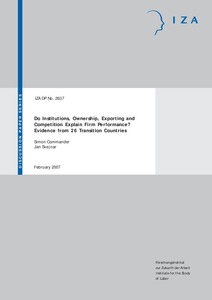Do institutions, ownership, exporting and competition explain firm performance? Evidence from 26 transition countries
"We analyze a large stratified random sample of firms that provide us with measures of performance and each firm’s top manager’s perception of the severity of business environment constraints faced by his/her firm. Unlike most existing studies that rely on external and aggregated proxy measures...
| Main Authors: | , |
|---|---|
| Institution: | ETUI-European Trade Union Institute |
| Format: | TEXT |
| Language: | English |
| Published: |
Bonn
2007
IZA |
| Subjects: | |
| Online Access: | https://www.labourline.org/KENTIKA-19133718124919519909-Do-institutions,-ownership,-ex.htm |
| Summary: | "We analyze a large stratified random sample of firms that provide us with measures of performance and each firm’s top manager’s perception of the severity of business environment constraints faced by his/her firm. Unlike most existing studies that rely on external and aggregated proxy measures of the business environment, defined to include legal and institutional features, we have information from each surveyed firm. Specifically, we use the 2005 and 2002 Business Environment and Enterprise Performance Survey (BEEPS) to assess the effect on performance of ownership, competition, export orientation and the business environment of the firm. We employ a variety of approaches to deal with the problem of omitted variables, errors in variables and endogeneity that plague studies in this area. We find that foreign ownership and competition have an impact on performance – measured as the level of sales controlling for inputs. Export orientation of the firm does not have an effect on performance once ownership is taken into account. When we analyze the impact of perceived constraints, we show that few retain explanatory power once they are introduced jointly rather than one at a time, or when country, industry and year fixed effects are introduced. Indeed, country fixed effects largely absorb the explanatory power of the constraints faced by individual firms. Replicating the analysis with commonly used country-level indicators of the business environment, we do not find much of a relationship between constraints and performance. Our analysis brings into question an important part of the conventional wisdom in this area. It indicates that country fixed effects, reflecting time-invariant differences in the business environment but also other factors, matter for firm performance, but that differences in the business environment observed across firms within countries do not. Moreover, the limited firm- and country-level variations in the business environment over time do not appear to affect performance either. This suggests that the effect of business environment on performance and the analysts’ ability to identify this effect are more limited than has been assumed to date." |
|---|---|
| Physical Description: | 55 p. Digital |

